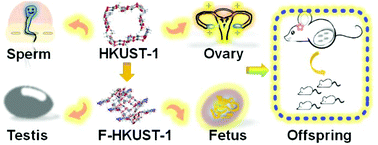Gender-dependent reproductive toxicity of copper metal–organic frameworks and attenuation by surface modification†
Abstract
Metal–organic frameworks (MOFs) as promising materials have been widely used in drug delivery, disease diagnosis and therapy; however, their effects on the reproductive system remain unknown, which hinders their further clinical applications. Here we show that repeated subcutaneous injections of copper MOFs (HKUST-1) induce higher toxicity into the male reproductive system relative to the female reproductive system, with disrupted seminiferous tubule histology, sperm generation disorder, irreversible sperm morphological abnormities and reduced pregnancy rate but only slight follicle dysfunction and pregnancy complications in female mice. Interestingly, the modification of HKUST-1 with folic acid attenuates the reproductive toxicity and even improves pregnancy and fetus development. This study confirms the gender-dependent toxicity of HKUST-1 to the reproductive system, and that folic acid modification could relieve the reproductive toxicity, thus providing us a deep understanding of reproductive toxicity of copper MOFs, and also a guideline and feasible way to improve the biocompatibility of copper MOFs for potential medical use.



 Please wait while we load your content...
Please wait while we load your content...